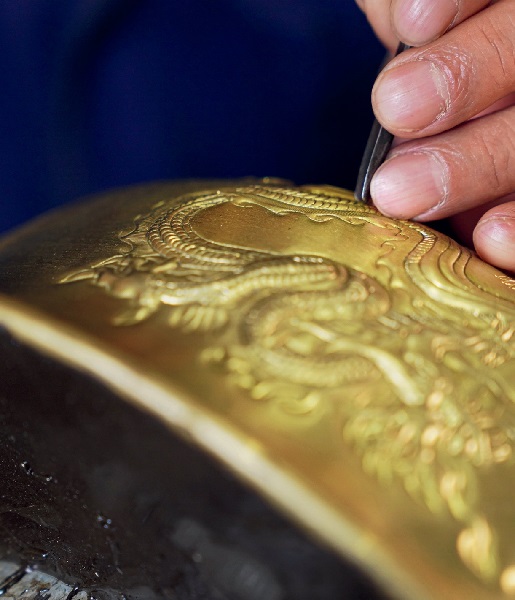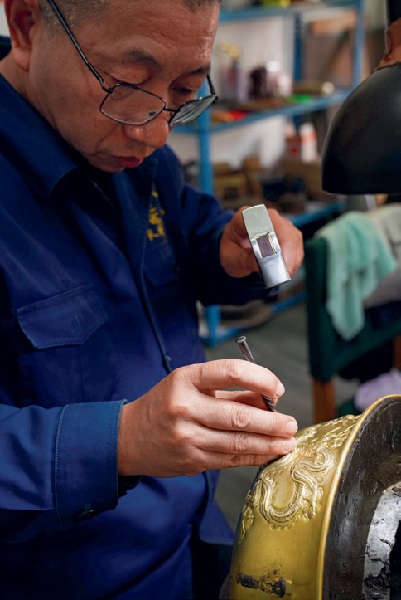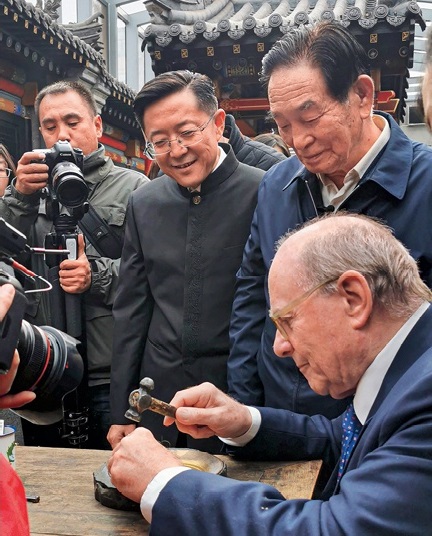The Datong bronze-making craft which has been passed down through the millennia still shines brightly today after countless hammer blows and engravings.

An artist is carving dragon patterns on the surface of a copper pot. Photo by Yu Xiangjun
Over 2,000 years ago, the bronze craftsmen in today’s Datong City, Shanxi Province, had already mastered the superb skills of copper production. Datong bronze-making craft was included in China’s state-level intangible cultural heritage list in 2014. The craftsmanship which has been passed down through the millennia still shines brightly today after countless hammer blows and engravings.

A dazzling array of copper products on display in Li’s store. Photo by Yu Xiangjun
Centuries-Old Craftsmanship
The rhythmic sound of striking metal can be heard coming from a shop on a street west of Shanhua Temple in the ancient city of Datong. Upon entering the shop, one is greeted by a dazzling array of brass products. In particular, there are rows of uniquely shaped and intricately engraved brass hot pots displayed on a shelf that attract many tourists passing by to stop and admire them.
The shop owner is 85-year-old Li Anmin, who moved from Shunping, Hebei Province, to Datong during his youth. He learned the skill of copper casting at a mining machinery factory, where he also worked as a lathe operator and a machinist. Li was transferred to the Datong Metalwork Factory as the factory manager back in 1978, during a time when Datong’s copperware was flourishing. “Back then, local people had to request approval from their leaders to buy copper hot pots (because of a short supply),” he recalled with a smile.
However, by the 1990s, with the rising prices of raw materials and the interruption of traditional craftsmanship, the Datong copperware, represented by the copper hot pot, began to decline. The factory where Li worked went bankrupt in 1998, and many employees switched to other industries. Li, on the other hand, with a sense of urgency and conviction that the craft must not be forgotten, invested RMB 80,000 of his own money, teamed up with several veteran craftsmen, and continued the manual copper processing in his small courtyard. He was determined to preserve and pass on the craftsmanship which had been passed down from previous generations.
After many years, their persistence finally paid off. Li established Tianyichang Artware Factory in 2002. A few years later, he opened a store in the ancient city of Datong that integrates production, display, and sales. Due to the large number of tourists that visit the ancient city, Li's shop gained a footing on the market, bringing new vitality to traditional Datong copperware. He was recognized as a representative inheritor of state-level intangible cultural heritage in 2017.
“Intangible cultural heritage skills are part of China’s cultural treasures. I must excel in my profession. We must be willing to invest effort and persevere to protect it. This embodies the craftsmanship spirit of us artisans,” said the elderly artist.

An artist is carving dragon patterns on the surface of a copper pot. Photo by Yu Xiangjun
Inheritance and Innovation
Copper is an important cultural symbol of Datong. Copper processing dates back to the Eastern Zhou Dynasty (770-256 B.C.). By the Northern Wei Dynasty (386-534), bronze foundry in the region had already reached its peak of development. During the Ming and Qing dynasties (1368-1911), Datong copperware dominated a large part of the national market. The range of products covered eight categories, including cookers for the imperial court, hot pots, writing utensils, wine vessels, and tea sets.
“The process of manufacturing one piece of copperware includes more than 10 steps before the piece is completed, such as selecting material, mixing alloys, melting, forging, soldering, engraving, tinning, and polishing,” Li explained. “Datong copperware is hand-forged, not cast, which makes it special,” emphasized the master craftsman. He stated that the heart of the manufacturing process lies in forging and engraving, as they put the craftsman's skills to the greatest test. “Engraving – whether it be a flat caving or relief – requires years to decades of practice.”
Li has trained many successors. “Of the dozen of apprentices I have trained over the last years, two have already become master craftsmen at the provincial level and five at the city level,” the 85-year-old said proudly. His focus now is increasingly on passing his craft on to the younger generation. In addition to training apprentices, he also holds activities at schools to raise awareness among children and adolescents about the ancient cultural heritage and encourage them to engage in its continuation.
The new generation of inheritors has become a new force for driving innovation in the industry. In the past, Li’s factory mainly produced traditional goods. “Now we also have new products, such as induction cooker, to adapt to the needs of the market,” said Li. Furthermore, Li’s team is experimenting with new design ideas. For example, they incorporate local elements from Datong into pot patterns. This has resulted in many new models of copper productions. “Today we offer pots featuring landmarks from our city, such as the Flying Apsaras of the Yungang Grottoes, as well as take inspiration from classic motifs of bronzeware from the Shang and Zhou dynasties (1600-256 B.C.). Our hope is to bring artistically valuable everyday objects into the lives of our customers. In addition, our products serve as excellent advertising for our city,” said the artisan.
His son, Li Xudong, now also holds the title of a national representative of intangible cultural heritage. According to the younger Li, the efforts that are being made to preserve and pass down the old craftsmanship are already bearing significant fruit, “Thanks to the support for intangible cultural heritage and the increasing appreciation for traditional cultural treasures, there is a growing awareness in China regarding the value of our copper goods.” This is also reflected in a consistently increasing number of orders for copperware, as stated by Li Xudong.

Under the guidance of Li, Alain Pompidou tries his hand at copper ware carving.
Going Global
In 1973, Premier Zhou Enlai, together with French President Georges Jean Pompidou, visited Datong. During a shared meal, President Pompidou spoke highly of the copper cooking pot on the table. At the conclusion of the visit, he was therefore presented with a copper cooking pot featuring the pattern of “Nine Dragons in the Moonlight” as a state gift. The design, inspired by the Nine-Dragon Wall in front of Prince Dai’s Palace in Datong, was combined with inlaying work, relief, and line engraving. The nine dragons on the pot breathe clouds and smoke – almost lifelike. When the Chinese side presented the gift to the French president, several domestic and foreign journalists captured the moment, instantly bringing global recognition to the copperware craftsmanship from Datong.
In 2019, the son of the president, Alain Pompidou, and his wife returned to Datong and showed great interest in the art of copper production. Under the expert guidance of Li, Alain Pompidou even attempted to work with the shiny material himself. “Since my father has also been here before, I feel a special connection to this city. I will take many beautiful memories from here back home,” stated the Frenchman at that time.
The strong connection which Alain Pompidou feels for Datong certainly pleased Li. “Alain Pompidou has announced his intention to establish an international art community here in Datong. In the future, it is expected to become a hub for art groups from around the world. We certainly hope that this initiative will further enhance the global recognition of our copper art,” said Li.